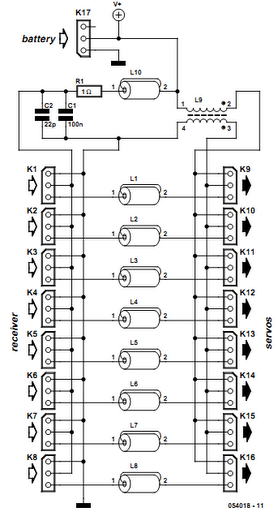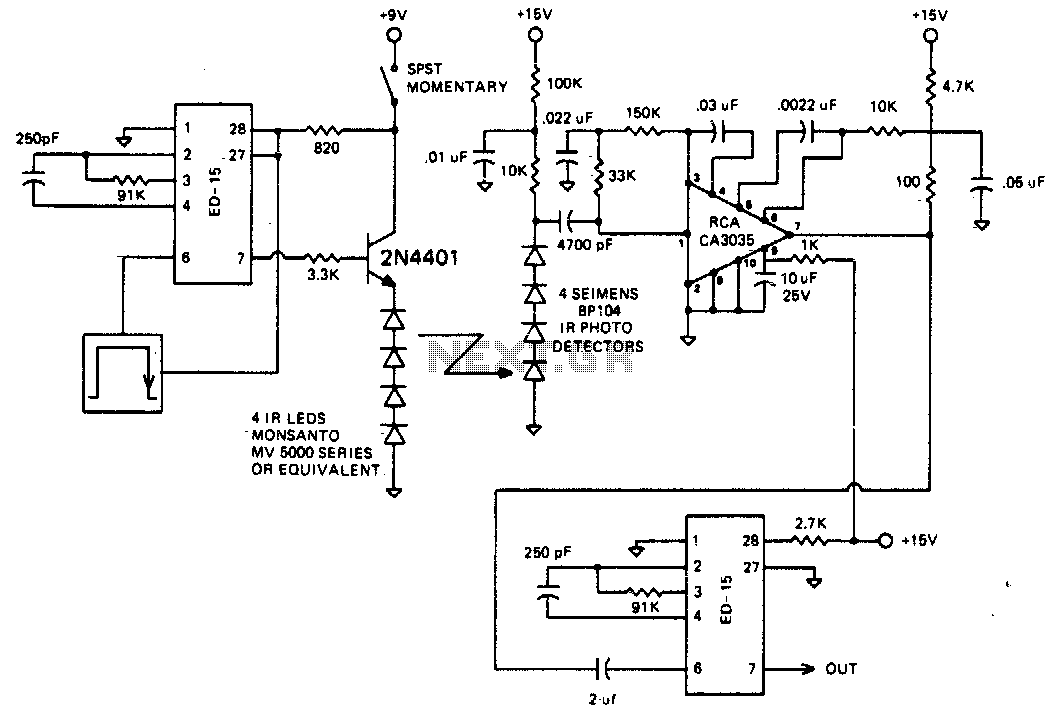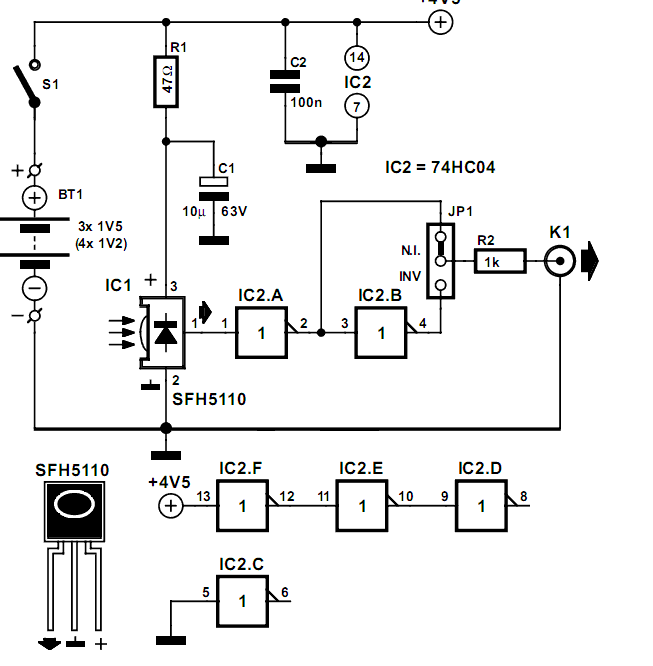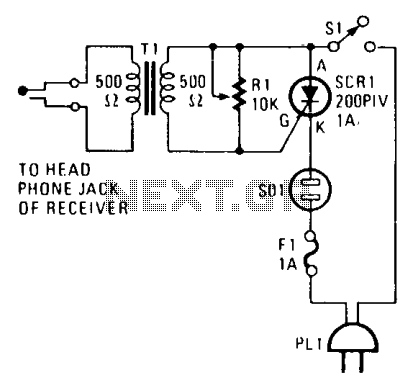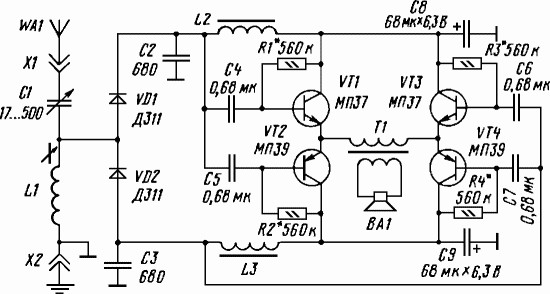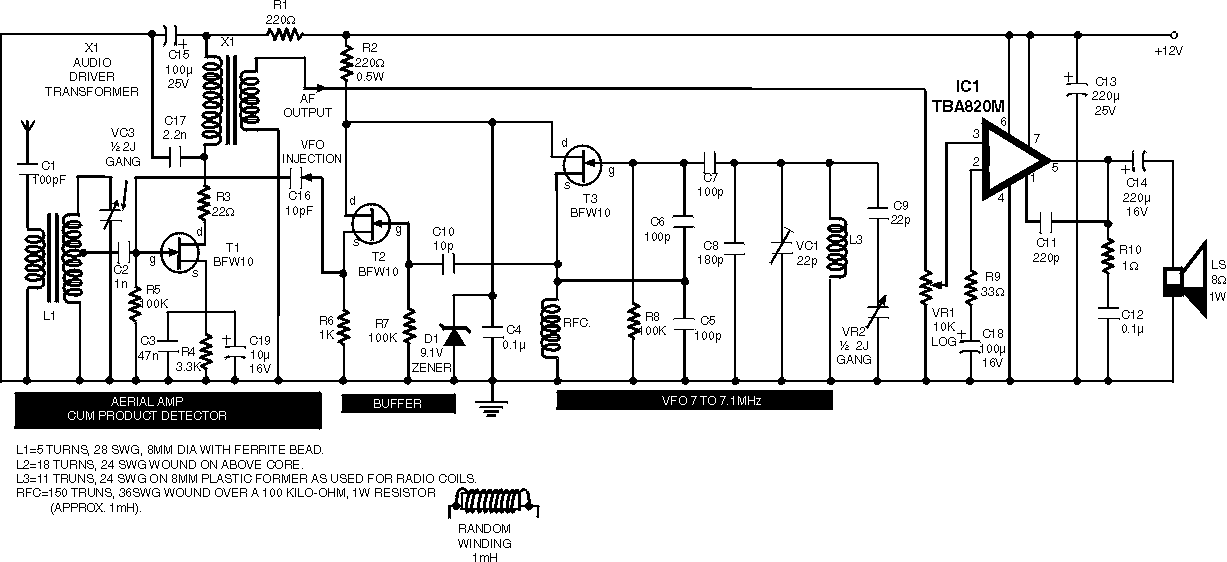
AM Receiver

This is a compact three-transistor regenerative receiver with fixed feedback. It operates similarly to the ZN414 radio IC, which has been replaced by the MK484. The design is straightforward, offering good sensitivity and selectivity. General-purpose transistors can be utilized in this circuit; three BC549 transistors were employed in the prototype. The tuned circuit is designed for medium wave frequencies but can function at higher frequencies with different tuning coils and capacitors. A ferrite rod and a tuning capacitor from an old radio were used, tuning from approximately 550 to 1600 kHz. Q1 and Q2 form a compound transistor pair that features high gain and very high input impedance, which is essential to avoid loading the tank circuit excessively. Q1 operates as an emitter follower, while Q2 functions in common emitter mode. Self-stabilizing bias is achieved through a 120k resistor and the tuning coil. Since Q2 operates in common emitter mode, its base voltage will be approximately 0.71V above ground in the test sample. The voltage at Q1's base will be this Vbe drop plus the voltage drop across the 1k resistor and Q1's own Vbe drop, resulting in a total of 1.34V from base to ground in the test circuit. For audio amplifiers, Q2's collector would typically be biased near half the supply voltage. However, input signal levels at radio frequencies are very low, generally around 50 µV across the coil, which Q2 amplifies to about 5 mV RF across the 2.2k load resistor. The 120k resistor provides regenerative feedback between Q2's output and the tank circuit input, and its value significantly influences the overall performance. Excessive feedback can lead to instability and a "howling" sound, while insufficient feedback results in a "deaf" receiver. If oscillation occurs, R1's value may be reduced to 68k; conversely, if sensitivity is lacking, R1 can be increased to around 150k. R1 may also be replaced by a fixed resistor of 33k in combination with a preset resistor of 100k to allow for adjustments in sensitivity and selectivity. Transistor Q3 serves a dual purpose: it demodulates the RF carrier while amplifying the audio signal. Audio levels fluctuate based on the strength of the received station, typically ranging from 10 to 40 mV (audio voltage, not RF signal level). This output can directly drive high-impedance headphones or be fed into a suitable amplifier. The tuning coil can be salvaged from an old AM receiver, or one can be constructed by winding about 50 to 60 turns of 26 SWG enamel-coated copper wire around a 3/8 inch ferrite rod that is approximately 3 inches long. AM stations are directional, so rotating the rod (or the entire receiver) can help nullify some signals while enhancing others. In areas with weak reception, an external antenna may be necessary. About 4 or 5 turns of 26 SWG wire should be wound onto the ferrite rod, close to the main winding, with one end connected to a cold water tap or ground connection. A few feet of flexible wire can be used as an antenna. All connections should be kept short, and a veroboard or tag strip layout is recommended. The tuning capacitor consists of fixed and moving plates; the moving plates should connect to the "cold" end of the tank circuit (the base of Q1), while the fixed plates should connect to the "hot end" of the coil (the junction of R1 and C1). Reversing the connections on the capacitor may cause unwanted stability and oscillation when nearby objects affect the capacitor.
This regenerative receiver circuit is particularly advantageous for its simplicity and effectiveness in receiving medium wave signals. The use of three transistors allows for efficient amplification and demodulation of radio signals, making it suitable for hobbyists and educational purposes. The design's adaptability to higher frequencies with appropriate components enhances its versatility. The inclusion of feedback mechanisms facilitates fine-tuning of performance, allowing users to optimize sensitivity and selectivity according to their specific reception conditions. The construction of the tuning coil and the careful arrangement of components contribute to the overall functionality and reliability of the receiver. Furthermore, the potential for salvaging components from old devices promotes sustainability and cost-effectiveness in building this circuit.This is a compact three transistor, regenerative receiver with fixed feedback. It is similar in principle to the ZN414 radio IC which is now replaced by the MK484. The design is simple and sensitivity and selectivity of the receiver are good. All general purpose transistors should work in this circuit, I used three BC549 transistors in my prototyp e. The tuned circuit is designed for medium wave, but the circuit will work up to much higher frequencies if a different tuning coil and capacitor are used. I used a ferrite rod and tuning capacitor from an old radio which tuned from approximately 550 - 1600kHz.
Q1 and Q2 form a compound transistor pair featuring high gain and very high input impedance. This is necessary so as not to unduly load the tank circuit. Q1 operates in emitter follower, Q2 common emitter, self stabilizing bias is via the 120k resistor and the tuning coil. As Q2 operates in common emitter its base volatge will be a Vbe drop higher than ground or about 0. 71V in my test sample. The volatge at Q1 base will be this Vbe drop plus the voltage drop across the 1k resistor and Q1`s own Vbe drop, this amounted to 1.
34V from base to ground in my test circuit. For audio amplifiers, Q2 collector would be biased near half supply voltage, however the input signal levels at RF are tiny, typically 50uV appearing across the coil being amplified by Q2 and being about 5mV RF across the 2k2 load resistor. The 120k resistor provides regenerative feedback, between Q2 output and the tank circuit input and its value affects the overall performance of the whole circuit.
Too much feedback and the circuit will become unstable producing a "howling sound". Insufficient feedback and the receiver becomes "deaf". If the circuit oscillates, then R1`s value may be decreased; try 68k. If there is a lack of sensitivity, then try increasing R1 to around 150k. R1 could also be replaced by a fixed resistor say 33k and a preset resistor of 100k. This will give adjustment of sensitivity and selectivity of the receiver. Transistor Q3 has a dual purpose; it performs demodulation of the RF carrier whilst at the same time, amplifying the audio signal. Audio level varies on the strength of the received station but I had typically 10-40 mV, this is audio voltage, not RF signal level.
This will directly drive high impedance headphones or can be fed into a suitable amplifier. The tuning coil can be salvaged from an old AM receiver. However to make your own wind about 50 to 60 turns of 26 swg enamel coated copper wire over a 3/8 inch ferrite rod about 3 inches long. AM stations follow are directional so rotating the rod (or whole receiver) should allow nulling of some signals whilst boosting others.
If you are in an area of weak reception then an external antenna may be required. Wind about 4 or 5 turns (indicated as 4 or 5 T on the schmematic) of 26 swg wire onto the ferrite rod, close to the main winding and connect one end to a cold water tap or ground connection. Use several feet of flexible wire as an antenna. All connections should be short, a veroboard or tagstrip layout are suitable. The tuning capacitor has fixed and moving plates. The moving plates should be connected to the "cold" end of the tank circuit, this is the base of Q1, and the fixed plates to the "hot end" of the coil, the junction of R1 and C1.
If connections on the capacitor are reversed, then moving your hand near the capacitor will cause unwanted stability and oscillation 🔗 External reference
This regenerative receiver circuit is particularly advantageous for its simplicity and effectiveness in receiving medium wave signals. The use of three transistors allows for efficient amplification and demodulation of radio signals, making it suitable for hobbyists and educational purposes. The design's adaptability to higher frequencies with appropriate components enhances its versatility. The inclusion of feedback mechanisms facilitates fine-tuning of performance, allowing users to optimize sensitivity and selectivity according to their specific reception conditions. The construction of the tuning coil and the careful arrangement of components contribute to the overall functionality and reliability of the receiver. Furthermore, the potential for salvaging components from old devices promotes sustainability and cost-effectiveness in building this circuit.This is a compact three transistor, regenerative receiver with fixed feedback. It is similar in principle to the ZN414 radio IC which is now replaced by the MK484. The design is simple and sensitivity and selectivity of the receiver are good. All general purpose transistors should work in this circuit, I used three BC549 transistors in my prototyp e. The tuned circuit is designed for medium wave, but the circuit will work up to much higher frequencies if a different tuning coil and capacitor are used. I used a ferrite rod and tuning capacitor from an old radio which tuned from approximately 550 - 1600kHz.
Q1 and Q2 form a compound transistor pair featuring high gain and very high input impedance. This is necessary so as not to unduly load the tank circuit. Q1 operates in emitter follower, Q2 common emitter, self stabilizing bias is via the 120k resistor and the tuning coil. As Q2 operates in common emitter its base volatge will be a Vbe drop higher than ground or about 0. 71V in my test sample. The volatge at Q1 base will be this Vbe drop plus the voltage drop across the 1k resistor and Q1`s own Vbe drop, this amounted to 1.
34V from base to ground in my test circuit. For audio amplifiers, Q2 collector would be biased near half supply voltage, however the input signal levels at RF are tiny, typically 50uV appearing across the coil being amplified by Q2 and being about 5mV RF across the 2k2 load resistor. The 120k resistor provides regenerative feedback, between Q2 output and the tank circuit input and its value affects the overall performance of the whole circuit.
Too much feedback and the circuit will become unstable producing a "howling sound". Insufficient feedback and the receiver becomes "deaf". If the circuit oscillates, then R1`s value may be decreased; try 68k. If there is a lack of sensitivity, then try increasing R1 to around 150k. R1 could also be replaced by a fixed resistor say 33k and a preset resistor of 100k. This will give adjustment of sensitivity and selectivity of the receiver. Transistor Q3 has a dual purpose; it performs demodulation of the RF carrier whilst at the same time, amplifying the audio signal. Audio level varies on the strength of the received station but I had typically 10-40 mV, this is audio voltage, not RF signal level.
This will directly drive high impedance headphones or can be fed into a suitable amplifier. The tuning coil can be salvaged from an old AM receiver. However to make your own wind about 50 to 60 turns of 26 swg enamel coated copper wire over a 3/8 inch ferrite rod about 3 inches long. AM stations follow are directional so rotating the rod (or whole receiver) should allow nulling of some signals whilst boosting others.
If you are in an area of weak reception then an external antenna may be required. Wind about 4 or 5 turns (indicated as 4 or 5 T on the schmematic) of 26 swg wire onto the ferrite rod, close to the main winding and connect one end to a cold water tap or ground connection. Use several feet of flexible wire as an antenna. All connections should be short, a veroboard or tagstrip layout are suitable. The tuning capacitor has fixed and moving plates. The moving plates should be connected to the "cold" end of the tank circuit, this is the base of Q1, and the fixed plates to the "hot end" of the coil, the junction of R1 and C1.
If connections on the capacitor are reversed, then moving your hand near the capacitor will cause unwanted stability and oscillation 🔗 External reference
